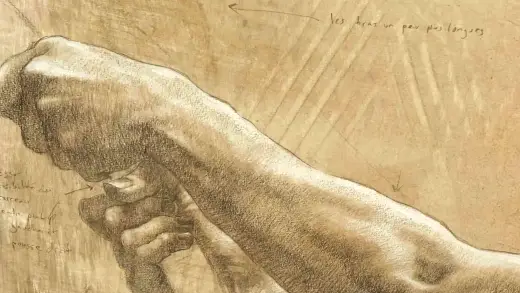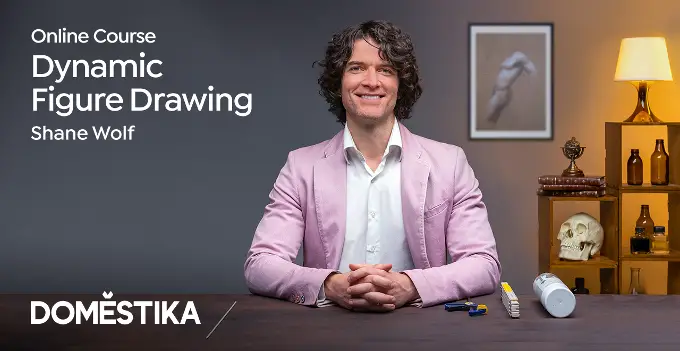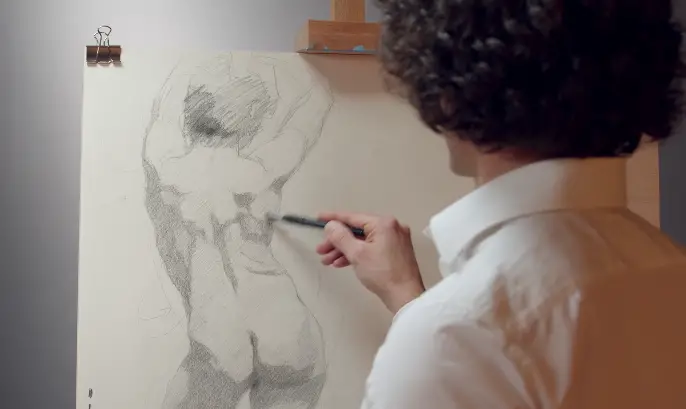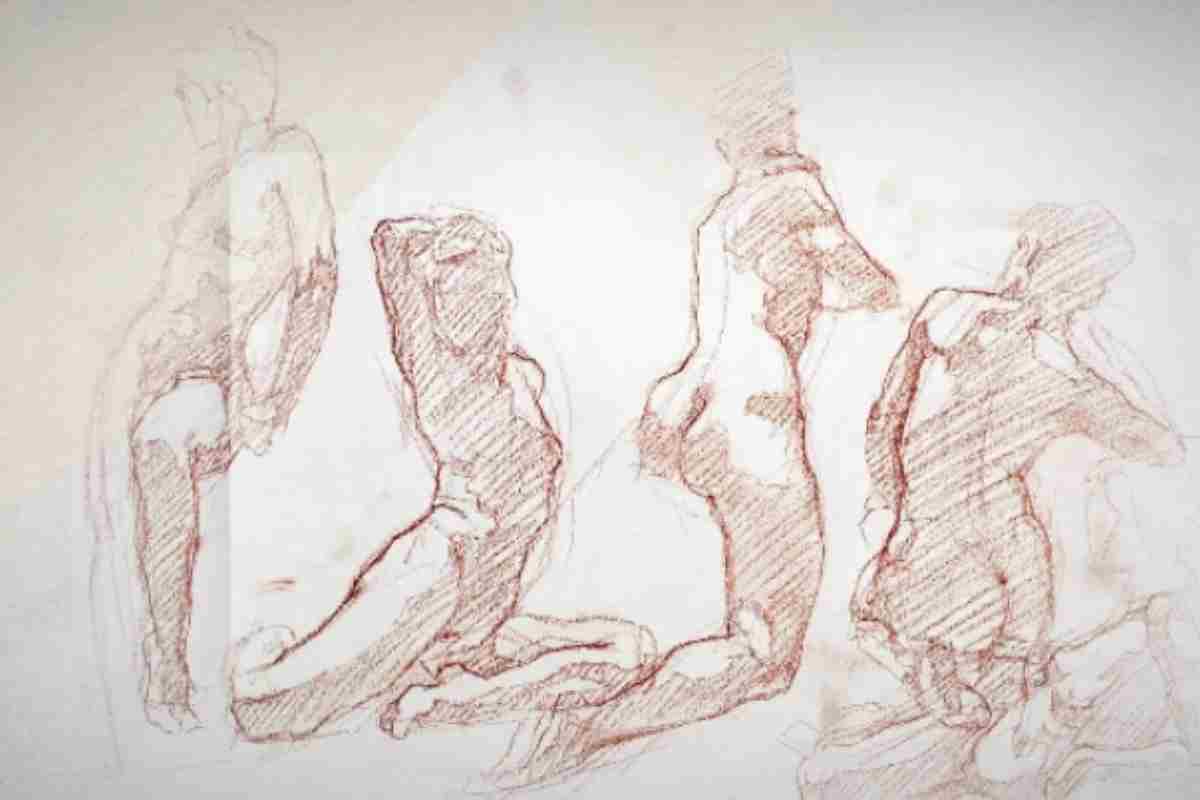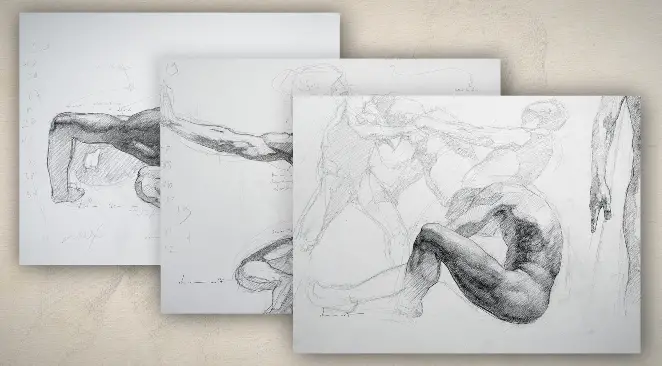What is Dynamic Figure Drawing
Dynamic figure drawing can be the difference between a highly successful drawing or painting and one that seems stagnant and dull. One of the most challenging things for an artist is to convey a sense of motion and energy in a drawing or painting. A drawing or painting is a flat, two-dimensional illustration. Getting that two-dimensional illustrator to depict motion can be very challenging. Use this link to access Drawing Courses at Domestika.
Use the following code to receive and 10% discount. IMPROVEYOURDRAWING-IMPRO10
But, as challenging as it can be, it can be done if you understand the principles involved. Like everything else involving art, the key to being successful at dynamic figure drawing is learning how to do it and then practicing the skills you learned until you master them. It won't happen overnight, but the time and effort you put into developing your figure-drawing skills will help you grow as an artist.
Drawing a Figure in Deep Space
The biggest challenge of drawing a figure that depicts a real sense of space is that you're working on a flat surface. You start out at a disadvantage because you try to fool the person's eye by looking at your artwork. Sculptors can create three-dimensional images that cast shadows and highlights naturally, and it's from sculptors that you should take your cues. Sculpting a figure is very different than drawing or painting one, but in the end, the goal is the same. To realistically depict a human figure, you must have the proportions right. That's the foundation, but what's next after that?
After sketching out the foundation and starting a drawing, the most important thing you must do is identify the highlights and shadows. This is how you create a figure in deep space. This is how you fool the viewer's eye into thinking that they aren't looking at a drawing or painting on a flat surface. Instead, they are looking at a three-dimensional image because you used light and shadows to create that illusion.
How do You Draw a Dynamic Figure Drawing?
If you want to draw a dynamic figure, you need to start out with a dynamic sketch. One common mistake that artists make is starting out with a too tight and formal sketch. Here's a simple rule to follow when laying out your initial sketch drawn with your entire arm. What does that mean? That means your wrist should not be resting on the paper. You should be making big, loose movements using your entire arm. Remember, the sketch isn't something that anyone is going to see. It's a guide for what comes next for you, the artist. Make a loose, free-flowing sketch that will help you develop a loose, free-flowing drawing.
What are Dynamic Drawings?
Dynamic drawings are eye-catching drawings. That's probably the simplest, most straightforward way to describe them. It doesn't matter what you use to catch your audience's attention. As long as people are taking notice, you're doing what you need to do. Dynamic drawings are often considered drawings that use lines, values, and colors to create a visually stimulating image. The most important thing to take away from this is that all drawings should start from a dynamic base. Create this base by using loose, sketchy lines, then build on that. Don't be afraid to get messy and make mistakes; it's all a part of the process. Just focus on creating something exciting to look at, then start building your shapes, lines, and values. Use this link to access Drawing Courses at Domestika.
Is Figure Drawing Good for Beginners?
Figure drawing is challenging. There's no way to get around that; figure drawing is challenging, but does that mean it's not something beginners should focus on? Absolutely not. If you want to be an artist known for depicting the human form, you need to practice drawing the human form.
You need to practice the subject matter that you want to master. Now, does that mean you should jump right into figure drawing without building a foundation in the basics? That depends. Some people have a natural aptitude for specific subjects. Like some people are taller, more athletic, or academically gifted, and some have a more natural artistic aptitude. This doesn't mean you can't develop as an artist if you aren't one of these people. It just means that you'll have to work a bit harder.
So, if you have a natural aptitude for figure drawing and everything involving visual art comes naturally to you, then you might be able to jump right into drawing figures. If you have to work on your skills to refine them, don't start by taking little steps. If you have to start by creating value scales and drawing and shading simple shapes, then that's just fine. Learning the basics will only help you build a stronger foundation that will serve you well in the future.
What is it about figure drawing that makes it so challenging? It's the familiarity that we all have with the human form. What's more familiar to us than the shape of our own bodies? If you're a landscape artist and you make a mistake and mess up a tree, there's a chance that your audience will never notice. But if you're a figure drawing artist, forget about it. Any mistake you make will be very easily spotted by most people, meaning you have to work harder to perfect your craft.
What is a Gesture Drawing in Art?
What is gesture drawing, and what makes it so important to master? A gesture drawing is a quick, loose sketch intended to capture the essence of a figure. There are no details or shadows. It's simply a sketch that helps you to get an idea for a more fully developed drawing. It can also be used as a foundation to further refine and turn into a finished drawing. Why should you spend time creating gesture drawings? Because it's a great practice! It helps you quickly get down the form of a figure and create that all-important sense of motion that will capture the eye of your audience. Remember, getting better at anything involves practice. Gesture drawing is a great way to practice drawing the human form.
Dynamic Figure Drawing By Domesika: Introducing Artist Shane Wolf
Domestika courses are a fantastic alternative to conventional classroom learning, provided, of course, that you have the right instructor. Use this Link to Access more information at Domesika.
Introducing Shane Wolf
Your instructor in this course is Shane Wolf, an artist that spent a good deal of time training in Florence, Italy. Known as the home of the Renaissance masters, training in Italy has given Shane Wolf a unique insight into the ways of the old masters. Combining their techniques with more modern ones, he has developed a unique style that has brought him a good deal of acclaim. Learning from a master such as Shane Wolf is always a good starting point when looking to draw the human figure.
Learn to Draw the Shape and Movement of the Human Body
Domesitka is a game-changer when it comes to connecting instructors with students. Technology has transformed all of our lives, mainly for the better. It's made learning something that can be done on your time. Who has time to go and sit in a classroom on someone else's schedule? With the pandemic that we're all currently living through, finding in-person classes can be difficult, so even if you want to go to an in-person class, you may not be able to find one. Domestika steps in to fill that void, giving students access to the help of expert instructors that will enable an artist to learn at their own pace.
In this Domesitka course by Shane Wolf, you'll get to learn from the experience of an expert. You'll get the type of first-hand insight and instruction that can help to transform you from an ordinary artist to an extraordinary one. While there are no magic shortcuts to becoming a great artist, this course will provide you with a road map that will help you get from where you are now to where you want to be in the future. Click here to access more information at Domesika.
Why Choose this Course
Are there other options out there if you want to learn to draw the human figure? Of course, so why choose this course? Because it is a great way to get a solid understanding of the fundamentals. This course will provide you with a roadmap that will detail each step in the process. You won't have to guess; you'll be shown, and that's invaluable. Have you ever been frustrated when you couldn't quite figure something out? Without an instructor to ask, you would be forced to experiment to find your own solution. While experimentation can be a lot of fun, it's time-consuming and frustrating when the solution eludes you. With this course, there's no guessing; you'll learn each step in the process. Then, after learning the process, you can add your own spin on things and develop your own style.
Benefits of This Course
There are a lot of benefits to this dynamic figure drawing course, which means that you'll improve as an artist. First, you'll learn techniques that will help you to improve the fundamentals. Next, you'll be shown step by step how to draw a dynamic figure. Finally, you'll get lots and lots of practice. What makes you better as an artist? Practice, but not just any type of practice, practice with structure and knowledge to guide you. That's what this course provides.
What Will We Do on This Course?
In this course, you'll start from the ground floor and work your way up. Each step of the way, you'll have expert guidance to show you what you should be doing and give you goal posts that you should aim for. Having the feedback of a real-life instructor is the gold standard, but that's a standard that's very difficult to meet given our current situation. This course gives you the next best thing: one-on-one instruction and tailored feedback. It gives you all the knowledge you need and shows you how you should progress, which lets you judge your own progress.
Materials and Basic Preparation
When preparing for your drawing class, we recommend that you have various art supplies on hand. You should have the standard basic supplies, such as graphite and paper, and any other materials you like to work with. If you like to work with ink, then, by all means, have pens or brushes on hand. If you prefer to work with charcoal, pastel, or any other medium, you can adapt the lessons you learn to fit your material choices.
Value and Value Scales
Learning value and how to transition between values is significant if you want to be able to draw a realistic human figure. Remember, the key to rendering a figure that looks realistic is to use highlights and shadows to create the illusion of a three-dimensional image. To do that, you a systematic approach to rendering highlights, shadows, as well as mid-tones. Although creating value scales may not be the most fun thing in the world, it will help you learn how to create different values and transition between them.
Light and Shadow
Another important aspect that this course will focus on is light and shadow. Dynamic figure drawing relies on many aspects. You must have a solid foundation, and you need a gestural drawing or sketch that focuses on form and motion. After that, light and shadow will be your best friends. You need to focus on using light and shadow to create the illusion of depth, and this course will show you how to do that.
Shape Exercises
Much like value scales, drawing simple shapes may not hold much interest for you. But, simple shapes are essential to learning because everything else you'll end up drawing can be broken down into simple shapes. An arm is simply a cylinder, as is a neck and leg. The head is an oval, and the body is a cube, at least a rounded cube. If you can learn how to draw simple shapes and apply light and shadow to simple shapes, you can draw the human figure. Always remember, no artist was ever hurt by practicing more.
Measuring: Do's and Dont's
There is a fine line that you must walk when drawing the human figure. That fine line is the line the separates precision and the importance of proportion from the importance of gestural drawing. Should you use measurements at certain times when drawing to ensure that your proportions are correct? Absolutely. Should you constantly measure as you work? No, because it will result in a dull and stagnant-looking drying. This Domestika course on dynamic figure drawing will teach you how and when you should measure and when you should let your instincts guide you. Use this Link to Access more information at Domesika.
Learn Anatomy Basics
What can be more important than understanding the basics of anatomy and the human body when it comes to figure drawing? Not much. If you don't have a basic understanding of anatomy, any drawing of a human figure won't look correct. You need to understand muscle groups and how they move beneath the skin. You need to understand how skin folds and how veins are positioned under the skin. If you don't understand these things, you won't succeed as a figure artist. It's one thing to draw what you see, but to truly capture the essence of a figure, you need to understand how the body works. This course will give you the basics of anatomy that every artist needs to know. You can then go out and build on this foundation to further develop your skills.
Short Pose Sketching
What is short pose sketching? This is one of those cases where something is exactly what it says that it is. Short pose sketching is all about doing quick, gestural sketches of the human form in different poses. In other words, it's more practice! What is practice good for? It's good for developing your skills and advancing your skill. The more you draw the human form in different poses, creating sketches that leap off the page the more comfortable you will become.
Step by Step Figure Drawing Tutorials
Have you ever wished that there was a simple, easy-to-follow, step-by-step guide that could show you how to draw a human figure from start to finish? Now there is! This course will show you everything from setting up a figure and lighting to your initial sketch to establishing values and your final rendering. Will this course make you a better artist? It should, so long as you put the work in. The best part is that the guesswork has been taken out of the equation. Spend time working on the training exercises, practice, then practice more. Then follow the step-by-step guide to create beautiful and dynamic figure drawings of your own. Use this Link to Access more information at Domesika.
How to Take Care of a Drawing
So you've mastered the art of drawing the human figure, now what? Well, first of all, there's no mastering it. There's only improving and refining your skills. With that being said, once you've reached a certain level of proficiency, you'll probably want to start saving your drawings. But how do you preserve them? What types of fixative are safe to use? Should you have them framed? Or is matting them enough? This course will also go over the steps needed to properly preserve your finished drawings so that they can be viewed and admired for many years to come.

